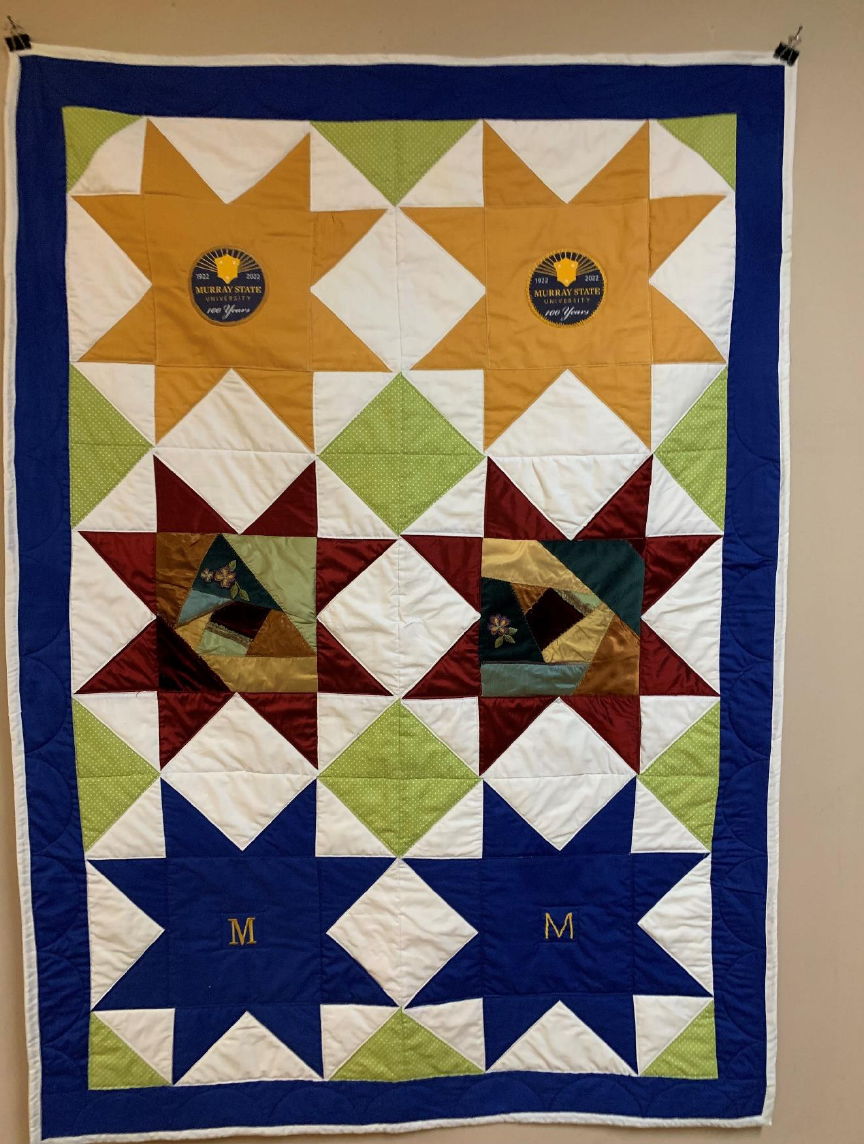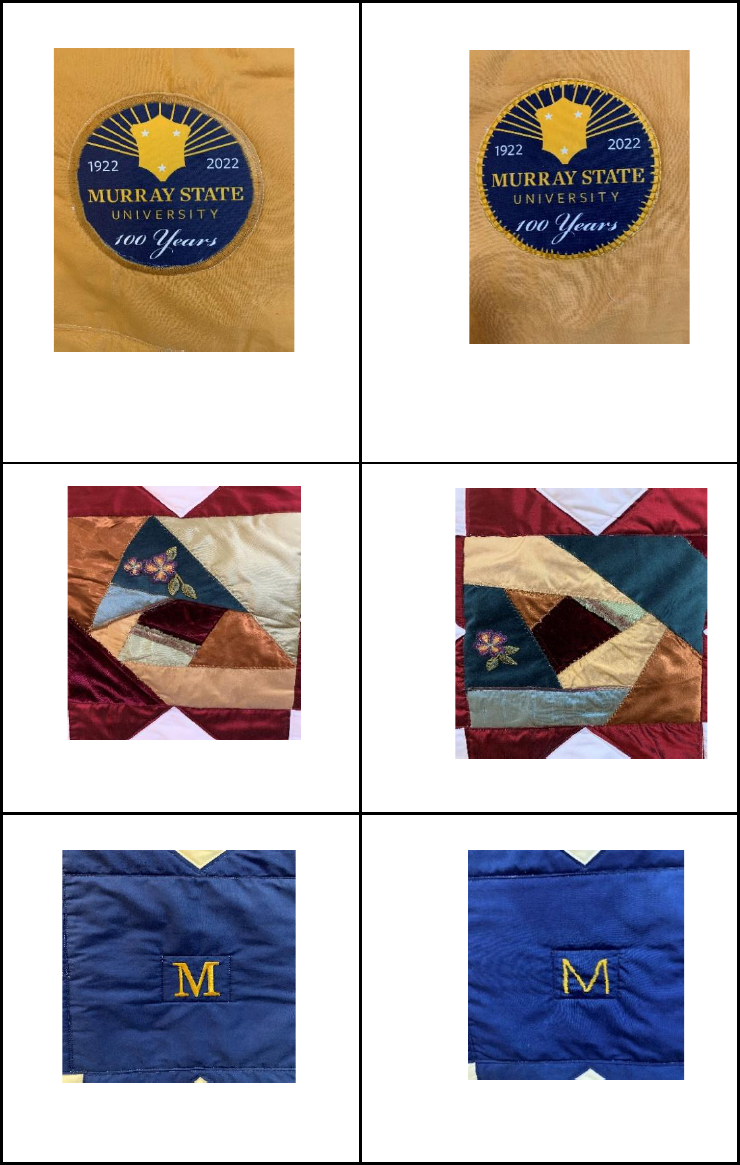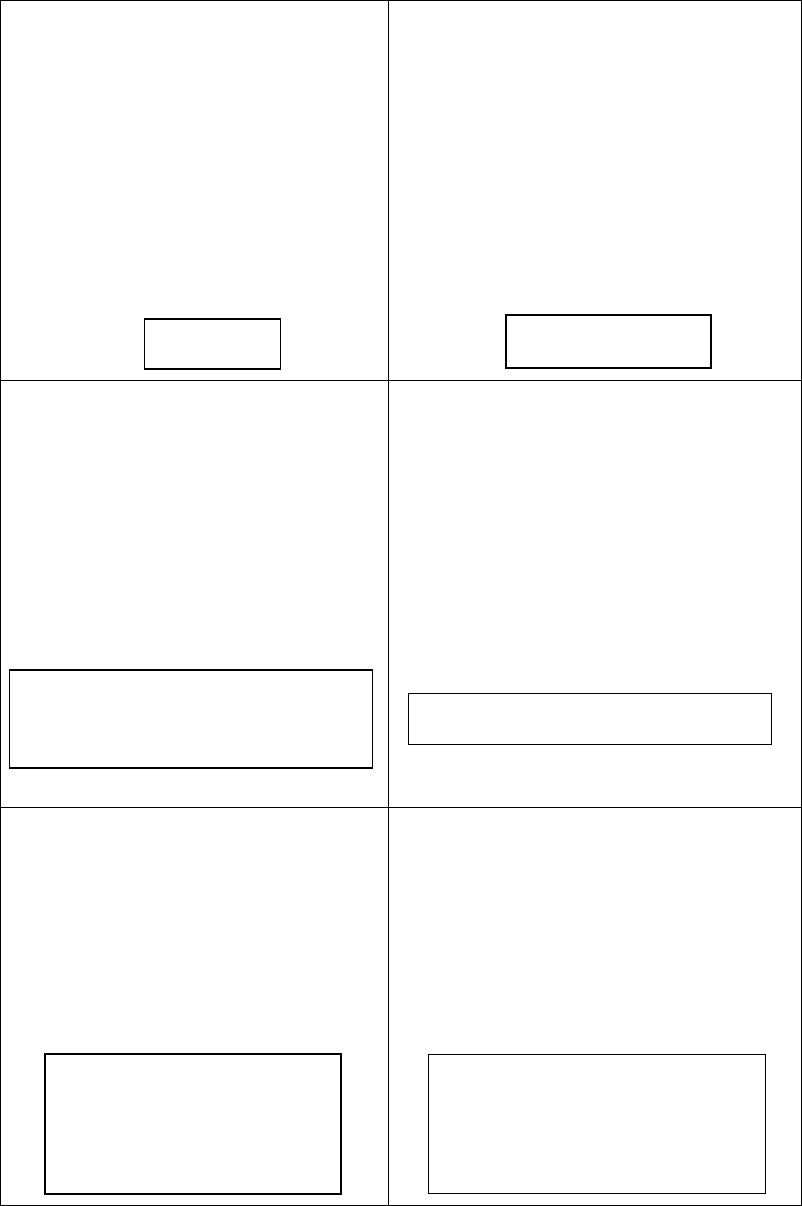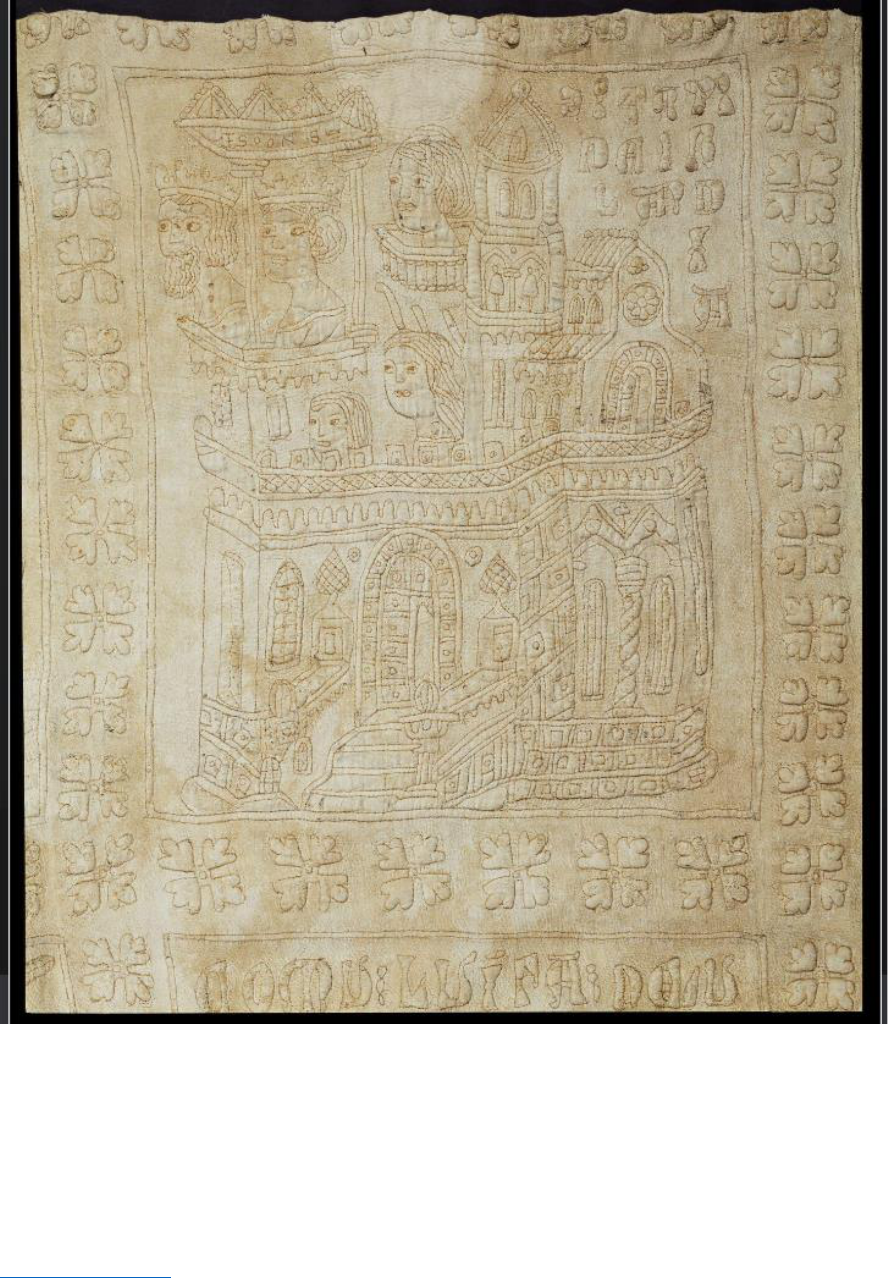
Murray State's Digital Commons Murray State's Digital Commons
Integrated Studies Student Works
Fall 2022
Technological Advancements in the Quilting Arts Technological Advancements in the Quilting Arts
Susan Wainscott
Follow this and additional works at: https://digitalcommons.murraystate.edu/bis437
Recommended Citation Recommended Citation
Wainscott, Susan, "Technological Advancements in the Quilting Arts" (2022).
Integrated Studies
. 453.
https://digitalcommons.murraystate.edu/bis437/453
This Thesis is brought to you for free and open access by the Student Works at Murray State's Digital Commons. It
has been accepted for inclusion in Integrated Studies by an authorized administrator of Murray State's Digital
Commons. For more information, please contact [email protected].
Running head: ADVANCEMENTS IN THE QUILTING ARTS 1
Technological Advancements in the Quilting Arts
Susan J. Wainscott
Murray State University
BIS 437-01: Senior Project
Dr. Scott Douglas
November 18, 2022
ADVANCEMENTS IN THE QUILTING ARTS 2
ABSTRACT
As it has in every area of life, technology has improved all parts of the quilting process.
Throughout history, inventions and discoveries have continued to make the quilting process
quicker than before. Quilts are not just for utilitarian purposes as they were thought of for
centuries, but are also a form of art. The recognition of quilts as such has not always been
acknowledged. Through historical and current facts and additional supporting information, the
quilt as an art form will be demonstrated. Documentation is presented partly in written form and
partly in the form of a lap quilt. The quilt project submitted has six panels. Each pair of panels
represents a specific needlework skill – applique, embroidery, and crazy quilting. Each of these
skills is represented in two ways – machine-made and hand-made. This comparison will show
that quilts are now made faster than before and, in some instances, even more aesthetic. Other
parts of the quilt were also constructed with the help of technology. Three different modern-day
machines were used in the creation of the lap quilt, demonstrating that the making of a quilt is
indeed improved by technology.
ADVANCEMENTS IN THE QUILTING ARTS 3
Technological Advancements in the Quilting Arts
While quiltmakers have steadily improved their sewing tools and skills, today’s
quiltmakers have more tools than ever before to allow them to create quilts with greater
precision, efficiency, and beauty. Sewing machines, quilting machines, quilt design software, the
internet, and innovative textiles are technological advancements that give quiltmakers the ability
to produce their beautiful modern-day creations.
Quilt Basics
To better understand technological advancements in the quilting arts, the fundamentals of
quilts must first be defined.
Quilts consist of three layers: The top, middle, and bottom (backing). There are three
methods used to create the top layer: a single piece (wholecloth), the stitching together of
different materials (piecework) or stitching one material on top of another (applique). Except for
wholecloth, quilts are made up of units called blocks. The middle is a single layer of some type
of insulating material, sometimes called batting. Another single layer of material makes up the
backing. Here, “quilts” is used as a noun, but it may also be used as a verb, as in: “Sally quilts in
her spare time.”
There are five steps to be completed before a finished quilt is created (Ausband, 2006):
1. Planning – The various designs of a quilt are endless and planning which block
pattern to use is no easy task. There are software programs now available that will
design a quilt based on what information is supplied to the program. Many
patterns are also available across the internet.
ADVANCEMENTS IN THE QUILTING ARTS 4
2. Cutting –All pieces of fabric are cut for the quilt block in this step. It is imperative
that the pieces are cut uniformly. There are now many tools to accomplish this,
including self-healing cutting mats, rotary cutters, plastic quilting rulers, and
more.
3. Sewing – This step is the actual attaching of all pieces together to form a block, as
well as attaching the blocks to each other. This, of course, was initially done by
hand, then with the invention of the sewing machine, the process became much
quicker. Now that computerized sewing machines have been created, there is
more control over how the stitching is done.
4. Quilting – This process attaches all three layers together. Initially, the layers are
basted, a process where the layers are pinned together randomly to temporarily
hold them together until the actual quilting is done. Like sewing, quilting was
originally done by hand, but later sewing machines were used. There are now
computerized longarm quilting machines available to do the quilting in a
relatively quick, efficient manner. With a longarm, initial basting is not necessary.
5. Binding – This step puts the finishing touches on the edges of the quilt so that no
unfinished borders are present. This can be done completely by machine, but
many times it is done by a combination of hand and sewing machine.
History of Quilts
Quilting has been done for centuries. The earliest existing quilt is a 14
th
century creation
made in Sicily known as the Tristan Quilt (See Figure 1). It has very ornate stitching and
trapunto detailing - a form of quilting where areas in the quilt top are packed with some sort of
material, usually cotton - creating three-dimensional areas. This quilt is considered the earliest
ADVANCEMENTS IN THE QUILTING ARTS 5
known form of an art quilt. There are 14 scenes across six panels, each scene showing events
related to the battle of Sir Tristan (The Tristan Quilt, 2004).
During the Crusades, ancient Asian quilting was brought to Europe, where various forms
of quilting were used to mend clothes and create household items to protect from the cold, such
as blankets and drapes. This quilting was originally done only by peasants, but soon the well-off
also began quilting. Even in Sicily where the climate was warmer, women made quilts for
decoration.
The colonists brought quilting to America. In those settling years, just as in Europe, the
quilts were made for utilitarian purposes, using them for warmth and to block drafts at windows
and doors. But as time went on, quilts became more and more elaborate and were, in some cases,
used simply for decoration. The most elaborate were preserved as heirlooms, some taking years
to create. From about 1750 to 1850, thousands of quilts were made, but only a small portion of
them have been saved (Brick, 2019).
The first quilts were made entirely by hand. The earliest known machine-sewn quilt can
be found in the Smithsonian Institute. It is a crib size quilt made in 1879 by Joseph Granger from
Worcester, Massachusetts. The story goes that his wife won a quilting contest with a quilt that
she made by hand. Granger thought it took her too much time to create, so he decided to show
her quilting by machine was much quicker (Bingham, 2010).
Around the turn of the century, manufactured quilts became available and quilt designs
underwent many changes because of this. Quilts were still created by hand, but with designs
influenced by flowers, occupations, people, and political activities. As manufactured bedding
became more prevalent, quilting began to die out. It was no longer something that had to be

ADVANCEMENTS IN THE QUILTING ARTS 6
done, but rather something used as a pastime. Only since then has it been that people have
considered buying or selling a domestic made quilt (Edelson, 1973).
Quilting became important once again during the World Wars. As America entered the
First World War in 1917, quilts and quilt making became a significant help to the war effort. The
government had a motto of, “Make Quilts – Save the Blankets for our Boys over There”. As the
Second World War was entered, quilts were made in an effort to raise money for the Red Cross
through raffles (Quilting in America, n.d.).
During the 1950s and 60s, once again quilting became less of a fascination with women.
It was usually viewed as a hobby only for older women, but the art of quilting was actually kept
alive by these women. Then in the 1970s and 80s, their descendants became interested in quilting
again. (Quilting in America, n.d.). In the current century, quilting still serves as a form of art by
those creative women (and, more and more often, men) that care to express themselves through
pattern, color, and quilting skill.
The “Great Quilt Revival in the art of quilting” has produced a market for buying and
selling domestic quilts in modern times. Quilts have become very popular, even being sold in
some of the largest boutiques in the country for hundreds of dollars. Quilts are now being seen as
art to collectors and are bought to be used in homes as decorations and even, in some cases, as an
investment. These old and new art quilts are now shown in major museums, with a detailed
description such as the name of the pattern used on the quilt and, when known, the date it was
created and the name of the creator (Edelson, 1973).
Technology has influenced how modern-day quilts are made in ways that vintage quilters
could never have imagined. Every phase of quilt making has been touched by it. Before

ADVANCEMENTS IN THE QUILTING ARTS 7
technology entered the picture, quilts were made using pattern templates made of paper, scissors
were used to cut the fabric and all phases of quilt construction were done by hand (Behuniak-
Long, 1994).
Once technology became available to the quilting community, the entire process of quilt
making changed. Books, magazines, or computers can help quilters envision the completed quilt.
A copy machine can reduce or enlarge a pattern if needed. Fabric shops now have an abundance
of factory-made material. Even if a fabric cannot be found in a brick-and-mortar store, it can be
ordered online or from a catalog. Fabric care can now include washing, drying and ironing. It can
be cut with a rotary cutter on a self-healing cutting mat, using special rulers dedicated solely to
quilting. Quilts can now be strip or chain pieced on a sewing machine in an assembly-line
manner. When it is time for the quilting step, there are patterns that can be traced on the quilt top
with water or air soluble chalk, pen, or pencil. A special attachment can be placed on the sewing
machine to be used in quilting or a special longarm quilting machine can be used to quilt in a
very short amount of time and the final step, binding the quilt, can be attached by machine
(Behuniak-Long, 1994).
Today, the average quilter spends $298 a year on quilting related items, which includes
about 3.7 magazines. Magazines are especially important, as they provide new tips and
techniques, insight into new products, and input to various useful quilting websites (Walsh,
2019).
According to QuiltingHub website, a 2017 survey shows estimates of 7-10 million
quilters in the U.S. The average quilter is female, 63 years old, and has been quilting for 19
years. The QuiltingHub survey also shows that more and more quilters are using the internet for
classes and videos (52%). Social media is being used by quilters as well (50%). In addition, they

ADVANCEMENTS IN THE QUILTING ARTS 8
are spending on average 7.9 hours per week on quilting related sites and 68% of these quilters
made online purchases of quilting supplies (Quilting Hub, 2017).
Quilting Bees and Guilds
Throughout the mid-18
th
century thru the early 20
th
century, many women participated in
quilting bees (Wang et al., 2009). Quilting bees were the gathering of women who would usually
do the actual quilting of the assembled quilt, but they were used as a time to piece quilts, too.
Quilting bees were also a source of information of quilting ideas, patterns, and other helpful
informatiion (Edelson, 1973). Quilting bees were sometimes referred to as quilting parties (The
Quilting Bee?, 2022).
Special quilting bees were held for women who were engaged, where a wedding quilt
was designed and pieced. Another quilting bee would be held to do the actual quilting. Other
special bees were held where a quilt for a special friendship or occasion was created (Edelson,
1973).
Quilting bees were also used to help in other textile work. Women’s diaries lent insight
into quilting parties. One woman, Martha Ballard, in her late 18
th
century diary wrote that
neighbors were teaching her daughters how to use a loom and that quilting parties were held to
coach them to “go to housekeeping” (Ulrich, 1991).
Since women were not allowed to voice their political opinions in public, the quilting
bees provided a platform to discuss their views. This is evident by the names of some of the quilt
patterns from that time, such as “Kings Crown”, “Whig Rose”, “Union Star” and “Clay’s
Choice”. It is also known that the first suffrage meeting was held at a quilting bee by Susan B.
Anthony (Edelson, 1973).

ADVANCEMENTS IN THE QUILTING ARTS 9
Throughout the 1900s, women continued holding traditional quilting bees, especially in
rural areas, but by the end of the 20
th
century, quilting bees were giving way to the creation of
quilting guilds and other small groups of quilters who still use the term “bees” in describing
themselves (The Quilting Bee?, 2022).
Quilt guilds began appearing in the 1970s. They are built on a democratic, formal system
that elect officers, determine membership dues, and create by-laws. Guilds are non-profit groups
that promote quilt making by passing along quilting knowledge and skills. Many quilting guilds
are now online clubs that provide all the functions of in-person clubs, but with the added
advantage of connecting people from all over the world (The Guild Movements, 2022).
“Virtual bees” is used in describing some online quilting communities (The Quilting
Bee?, 2022). Even though these online bees do not include actual quilting by a group of in-
person women, they do continue many of the original, in-person quilting bee traits, in that
patterns, ideas, and other information are exchanged. Online sites also allow women to “display”
their creations through pictures and to discuss the history of old quilts they may have. Another
use of the online sites is that commercial websites can be introduced to the women that tell of
places to, for example, sell their quilts and where to buy quilting supplies. Many online quilting
sites provide a teaching platform. These sites give out tutorials, free patterns, and other quilting
information (Gainor, 2011).
Invention of the Sewing Machine
The question of who invented the sewing machine is difficult to answer. A complete
sewing machine was not invented by one person, but rather, various functions of the sewing

ADVANCEMENTS IN THE QUILTING ARTS 10
machine were invented by different people over several years. A man by the name of James
Edward Allen Gibbs was one of the first innovators of the sewing machine and had seen
throughout history all the important sewing machine advancements. In 1901, as an old man, he
was interviewed for his views on the invention of the sewing machine. He stated (Askaroff, n.d.):
No useful sewing machine was ever invented by one man; and all first attempts to do
work by machinery, previously done by hand, had been failures. It was only after several
able inventors had failed in their attempts, that someone with the mental powers to
combine the efforts of others, with his own, at last produced a practicable sewing
machine.
The man he was describing was Elias Howe, a Massachusetts farmer, who invented (in
1844) and patented (in 1846) the first complete unit that could actually function as a sewing
machine (Loscalzo, 2005). This machine was commonly called a treadle machine. A treadle was
the mechanism which was pedaled turning a wheel that pushed the needle in and out of the
fabric. Howe could not find financial support in the United States, so he went to England, but
returned in disappointment and financially broke. Once he returned to the United States, he
found that others had improved on his machine and were producing their own. He sued these
men and made a fortune in doing so (Askaroff, n.d.). One of these men, John Bachelder, never
actually manufactured any sewing machines, but, instead, sold his rights to Isaac M. Singer in
the 1850’s.
After further improvements on the machine, and a new patent, Singer sold his machines
for $125 (Loscalzo, 2005). This was very expensive for the time, so to own one was considered a
luxury. Even so, the machine was worth the price since all clothing, quilts, and other home items

ADVANCEMENTS IN THE QUILTING ARTS 11
were made by tedious, time-consuming handiwork. In some cases, women would combine the
money necessary to buy a machine and share it among themselves (Bingham, 2010). By 1856,
Singer created a new lighter machine and was able to sell it for just $50. That machine, being too
light to handle certain sewing functions, was improved upon and sold for $75 (Loscalzo, 2005).
One of the major incentives to women for a home sewing machine was the
installment plan, which Singer initiated. Later, there was also a trade-in plan, also initiated by
Singer where a $50 credit was given toward the buying of a new machine. These incentives lead
to a 40% growth in sales. It is estimated that by 1860 nearly a half million sewing machines were
being used in the United States, both commercially and in the home (Loscalzo, 2005). Singer
ended up being a multimillionaire because of his skillful marketing practices (Contrado, 2019).
Singer remains the name most associated with the sewing machine today.
It must be recognized that until the invention of the sewing machine, every stitch
was done by hand making the sewing machine one of the most important inventions in its time.
The interest in sewing machines went in and out of favor over many years. Even with its
popularity during the middle of the 19
th
century, it soon became less admired. By the late 19
th
and early 20
th
centuries, handiwork became more widely used (Bingham, 2010). Marguerite
Connolly, in writing on the falling popularity of the sewing machine between 1890 and 1925,
wrote (Connolly, 1999):
By 1890 the sewing machine had lost its novelty and had become an accepted part of
domestic life. It was now too common for its prior status symbol role, and the American
public had begun to take it for granted….The sewing machine was ubiquitous in America
by the end of the 19
th
century.

ADVANCEMENTS IN THE QUILTING ARTS 12
With this handiworking period, crazy quilting became the form of quilting in vogue, but
did not last long as doing piecework and applique once again came into fashion. Even though
handiwork was popular, quilting by sewing machine was not completely gone as a useful tool in
quilting and soon became acceptable once again (Bingham, 2010).
In support of machine quilt making, Jean Ray Laury stated in her 1970 book Quilts &
Coverlets: A Contemporary Approach (Laury, 1970):
The development of technology…gave us a sewing machine that can be utilized as an
extension of the hand. It is possible to exert better control over these new machines than
over previous ones…The use of this efficient and versatile machine should not be
regarded as an “impure” approach to quilting but as a means of expanding the potentials
of designing.
In 1980, Robbie Fanning, along with her husband Tony wrote a book titled The Complete
Book of Machine Quilting. They extoled that quilting by machine produced a product that could
be machine washed and quickly made, two things not achieved with hand sewing (Fanning,
1980).
Once Harriet Hargrave wrote Heirloom Machine Quilting in 1987, machine quilting
became a craze (Hargrave, 1987). Quilt shops were overrun with people wanting to learn about
machine quilting and the shops needed more instructors than they could find (Bingham, 2010).
Although now widely accepted, there were still those that would not recognize machine
quilting as true quilting. This was demonstrated in 1989 when the Best of Show ribbon from the
American Quilter’s Society’s yearly quilt show in Paducah, Kentucky, was won by Caryl Bryer
Fallert for her creation of a quilt titled Corona II: The Solar Eclipse (now on display at the

ADVANCEMENTS IN THE QUILTING ARTS 13
National Quilt Museum). Her quilt was machine quilted and was the first of this kind to win the
award. Many quiltmakers at the show were so upset that a hand quilted quilt had not won that
they canceled their membership in the society. Still, machine quilting was so popular that
notions, battings, thread, and other tools and textiles were being created by manufacturers
specifically for this form of quilting (Bingham, 2010).
After all the decades-long controversy of machine vs. hand quilting, some modern-day
machines have the capability to create stitches that resemble hand quilting. All machine quilters,
whether with these fabricated hand stitches or with regular straight stitches, are now recognized
as artists in their own right.
In 1979, the world’s first programmable computer sewing machine was introduced – the
Janome MEMORY 7 Model 5001. The Janome website lists several built-in functions of this
first computerized machine (Janome, n.d.):
• Multiple decorative stitches could be combined to create a custom stitch
pattern.
• Mirror images of stitch patterns could be created.
• Up to 26 computerized stitch patterns could be utilized.
• Automatic stitch pattern parameters, such as stitch width and length were
set when a stitch pattern was selected. However, they could still be
adjusted manually, if needed.
This Janome summary shows the technological improvements in a computerized
sewing machine. None of these improvements were available on any previous sewing

ADVANCEMENTS IN THE QUILTING ARTS 14
machines. This was all in a time that PCs were not in most homes, so a computerized
sewing machine was a true advancement.
Longarm Quilting Machine
When the sewing machine first became available, the thought of creating a machine
solely dedicated to the quilting step materialized. The first manual machine was created in 1871
and was a simple machine made up of only a wooden frame and a sewing machine. The quilt
would be mounted on the quilting frame below the machine. The user would move the frame
under the machine, like moving a paper under a stationary pencil. One of the biggest problems
was that only straight, parallel lines could be stitched (Reed, S., 2016)
The original design of this machine was improved in 1877, making it similar to the
present-day longarm quilting machines. With these improvements, the sewing machine was
moved over the fabric via a hand crank. This changed the process to resemble moving a pencil
over paper. Once electricity became available, the hand crank was eliminated (Kallinger, J.,
2019).
As time went on, a wooden quilting frame was used, which had two bars on a stand. The
quilt was placed on the bars and as the hand stitching was done, the quilt was rolled up to expose
the next section of unquilted area. Today, a person can choose to continue using hand quilting,
but there are two more choices: The home sewing machine and the longarm quilting machine
(Reed, S., 2016).

ADVANCEMENTS IN THE QUILTING ARTS 15
Each of these three processes has its advantages and disadvantages (Reed, S., 2016):
PROS
CONS
Hand
1. Cheapest Option
2. Enjoyment of Making
a Quilt Completely by
Hand
1. Time Consuming
Home Machine
1. Time Saving
2. Reasonably Priced
1. Difficult to Maneuver
an Entire Quilt
Longarm Quilting Machine
1. Time Saving
2. Even Stitching
3. No Basting Needed
1. Size and Weight
2. Cost
Another possible option is to send a quilt to a professional machine quilter. This can be
expensive, but for those without the patience or means to do hand or sewing machine quilting,
this is a viable choice.
A modern longarm quilting machine consists of the actual sewing machine unit, a metal
frame on which the quilt is attached, and a worktable. The frame must be wide enough to
accommodate the largest quilt to be finished. Frame dimensions are usually between 10 and 14
feet long. (Reed, S., 2016). A longarm quilting machine can weigh as much as 7,000 pounds and
can range in cost from an average of about $4,000 (Kallinger, J., 2019) up to $30,000 or more
(Reed, S., 2016).

ADVANCEMENTS IN THE QUILTING ARTS 16
The sewing machine unit is on wheels and can roll horizontally and vertically between
the frame rollers. There are two types of longarm sewing machines (Reed, S., 2016):
• Hand-guided machines have handles so that the machine can be moved to create
the wanted design.
• A computer-guided machine has built-in patterns that can be selected to
automatically create the pattern without much assistance from the user.
A longarm quilting machine has some similarities to a home sewing machine. Both have
a thread tension dial that regulates the thread supply rate and the capability to change the SPI
(Stitches Per Inch). One difference is that the speed of the machine is controlled via a foot pedal
on a home sewing machine, but with the controls in the handles on a hand-guided longarm and in
the handles or the programmed computer on a computerized longarm.
There are two styles of quilting on a longarm quilting machine (Reed, S., 2016):
• Pantograph:
A pantograph design is a design that runs the length of the table. By using
either a stylus or laser on the sewing machine, the design is traced onto the
quilt. Because there is little effort required of the user, pantographs are
very popular.
• Custom:
A custom design is simply a design done by manually moving the sewing
machine over the quilt, producing any pattern wanted. The custom style
requires more intensive labor.
The longarm quilting machine can be a sit-down or standup machine, but there is another
sit-down machine that is sometimes called a midarm quilting machine. This machine is basically

ADVANCEMENTS IN THE QUILTING ARTS 17
like a large sewing machine attached to a sizeable table. On the midarm machine, the quilt is
moved under the machine. The advantage of a midarm over a regular home sewing machine is
that the distance between the needle and the machine motor is wider than on a home sewing
machine (American Patchwork and Quilting, 2013). The distance between the needle and motor
is called the bed. A midarm quilting machine has a bed of 11 to 19 inches while a home sewing
machine has a much smaller bed – usually six to seven inches wide and a longarm quilting
machine has a bed of 20 to 36 inches (Bingham, 2010). Having a longer bed and a bigger table
allows the sewer more support for the quilt while being able to quilt a larger portion at a time
(American Patchwork and Quilting, 2013).
Below are a few of the features on what is considered to be one of the best computerized
longarm quilting machine on the market today, the King Quilter II ELITE: (Reed, S., n.d.):
• Front and rear handlebars for working from both sides
• 7” Touchscreen
• Easy autosize, rotate and repeat patterns
• Up to 2,200 stitches per minute
• Four to 22 stitches per inch
This gives an idea of what is available on an advanced longarm quilting machine,
showing how far these machines have come since the early days of hand cranked machines.
Computerized Quilt Design
Quilt patterns can be obtained by passing from one quilter to another, downloading from
the internet, or copying the pattern from a quilt that has been seen. For an original quilt pattern
many quilters draw the imagined pattern on graph paper with colored pencils; however, in this
age of technology, electronic quilt design options are available.

ADVANCEMENTS IN THE QUILTING ARTS 18
The first quilt design software was created on an IBM computer in 1986 by botanist and
quilter, Nina Antze. The software was named PCQuilt. After purchasing her computer, she
realized that they are great tools for quilt design, storage of quilt-related data, and reading quilt
history. Dean Neumann and Penny McMorris developed design software called Electric Quilt in
1991. This software is still being used today. By 1999, two more quilt design programs were put
on the market: Quilt-Pro and QuiltSOFT (Quilt Software, 2022).
Quilt design software can now be purchased as stand-alone software for a computer or as
an add-on to the existing design software. These programs have large block and fabric
collections that the quilter can draw upon in designing their quilt. Quilters can even scan in their
own fabric to be added to the software’s fabric collection.
Some advantages of using quilt design software are (Ronne, M., 2021):
• Create original block patterns
• See a quilt “finished” before cutting any fabric
• Determine the size of the quilt design
• Endless possibilities for what can be created
• Use built-in block designs
There are three sources for computerized quilt designs:
1) Built into the sewing machine
2) Free on the internet
3) Purchased separately
The Quiltdom website reviews five of what they consider to be the best quilt design
software programs (Ronne, M., 2021):

ADVANCEMENTS IN THE QUILTING ARTS 19
1) Brother SAPVQ Preview Quilting Design Software:
This software has 150 built-in blocks. Templates are printable. Cost $99
2) Grace Quilter’s Creative Design Software:
This software has 200 built-in patterns. It also gives the ability to upload the
quilter’s own images and trace them to create original patterns. With this
software, quilts can be designed from start to finish because it has built-in quilting
stitch patterns. Cost $299
3) EQ8 by The Electric Quilt Company:
This software has over 6000 built-in patterns. Images can be uploaded and put
into the quilt design feature. Fabric images can be scanned into the software
allowing the quilter to see exactly what the quilt project will look like before
cutting any fabric. Images can be exported in five different file types. 10 layout
styles and 22 border options. Templates can be printed out, design layouts are in
full color, and yardage estimates are given. Cost $239.95
4) EQ8 Mini by The Electric Quilt Company:
This software is a beginner’s version of the EQ8. It has 300 built-in patterns, four
layout styles and eight border options. Templates and yardage estimates can be
printed. Cost $89.95
5) Prequilt App:
This last option is the latest in quilt design technology. It is a subscription-based
website rather than stand-alone software installed on the user’s computer. With
this subscription the user can design a quilt online by using a phone, tablet, or
computer. Pattern designers can submit quilt patterns, and then users can color the

ADVANCEMENTS IN THE QUILTING ARTS 20
patterns using whatever colors/fabrics they would like to see in the pattern. There
is a fabric calculator provided as a free feature to help calculate how much
yardage is needed to purchase for the project. There are many other options which
are available based on what subscription level a person has. Free, $5/month
($50/year), or $10/month ($100/year).
The development of computerized quilt design software has opened nearly endless
possibilities in quilt design. This software sounds as though only a professional quilter would use
it, but hobbyist users find these quilting tools useful in their designing process also.
Innovative Textiles
Some of the newest advancements in quilting are the present-day fabrics available. The
fabric traditionally used in quilts is cotton; however, the latest fabrics and fabric treatments offer
advantages that help produce quilts with unique traits.
The term nanotechnology is one that most have never heard, but it is the latest technology
being applied to textiles, so it may very well become a common word at some point in the future.
Nanotechnology is not easy to define because of its complex scientific description, but in its
simplest scientific term, “…..nanotechnology can be described as activities in the level of atoms
and molecules which have applications in the real humankind”. It produces greatly enhanced
products of all types, including cotton fabrics (Wong et al., 2006). The process of producing
these improved fabrics through nanotechnology is achieved by applying nano-particles to fibers,
which are then used in establishing new fabric traits and improvements. A common term used for
fabrics treated with nano-particles is “smart” fabric (Singh et al., 2006). Smart fabrics are high-

ADVANCEMENTS IN THE QUILTING ARTS 21
performance and cost-effect fabrics, making them popular among many users. They also perform
very differently than the same fabric in its natural state (Edden, S., 2016).
As a result of being treated with nano-particles, properties of these textiles include soil
resistance, water repellence, wrinkle resistance, anti-static, anti-bacteria, and flame retardation;
all of which may produce fabrics that will be self-cleaning and odor reducing at some point in
the future (Sustainable Nano, 2018). Also, applying nano-particles to fabric does not affect the
hand feel or the breathability of the fabric (Wong et al., 2006).
Even with all these advantages of the newly treated textiles, one of the most useful traits
for quilts is its ability to regulate body heat. People usually handle changes in temperature
around them through their clothing, dressing in warm clothes when it’s cold and cool clothes
when it’s warm. By regulating the body’s temperature, the need for dressing in layers can be
eliminated. This new fabric is knit from “carbon nanotube-coated triacetate-cellulose fibers”,
allowing the fibers to actually fluctuate based on the temperature of a person’s body (Halford, B.
2019). As a result of this new knit fabric and its heat regulating capability, quilts can be more
comfortable and efficient.
This smart fabric was developed by a team at the University of Maryland, College Park,
under the direction of YuHuang Wang and Min Ouyang. According to Wang, these carbon
nanotubes first perform like a metal, essentially changing the fibers of the fabric into small
antennas. As infrared radiation is expelled from the body, the fibers in the fabric act in different
ways. Heat and moisture determine the space between the fibers. Fibers are spaced closer to each
other when the environment is hot and wet, allowing infrared radiation to escape, but the space
between them is increased if the environment is cold and dry not allowing the infrared radiation
to escape. Wang also states that the fabric can be washed and dyed just as cotton can and that it

ADVANCEMENTS IN THE QUILTING ARTS 22
continues to feel like cotton. One of the concerns in using fabrics coated with nanotubes is with
safety, but these possible problems are being researched (Halford, B., 2019).
Quilting and Cyberspace
Amanda Sikarskie coined the term “Fiberspace” around the turn of the century.
Fiberspace covers all forms of the textile arts found on the internet. Quilting aspects included in
fiberspace are quilt patterns, educational instruction, quilt history sources, virtual quilt museums,
supply sources, informal social media groups, an online source for quilt study titled the Quilt
Index (Sikarskie, 2011), and many more internet quilting components.
A written work in technology and quilting, The Quilter’s Computer Companion by Judy
Heim and Gloria Hansen (Heim & Hansen, 1998) served as a comprehensive source of the use of
computers and the internet by quilters in the late 1990s. This work gave quilters a plethora of
information on everything from buying a computer, quilting software for every part of quilting,
including design, applique and embroidery, and transfer of photos to fabric, to name a few.
Quilts As an Art Form
Quilting began as a style of handiwork born out of necessity, but through the years has
developed beyond a mere necessity into an art form. Art is defined in the Merriam-Webster
dictionary as “The conscious use of skill and creative imagination especially in the production
of aesthetic objects” (Merriam-Webster, n.d.). This is a perfect description of quilting and the
“aesthetic objects” of quilts.
The International Quilt Museum World Quilts (an academic virtual museum within the
University of Nebraska-Lincoln) considers the question, “Are quilts art?” (Quilts As Art, 2022).

ADVANCEMENTS IN THE QUILTING ARTS 23
It has been asked around the art, craft, and quilt communities for at least a century. Art historian
Sandra Sider and artist Michael James have identified art quilts as holding a precarious place at
the juncture of art, craft, and design (Walsh, 2019). Neither the art community nor the quilt
community may completely claim quilts as theirs, but the artists that make them have
successfully challenged the boundaries of arts and quilts (Quilts As Art, 2022).
The history of quilts evolving into a firmly recognized art form in the general quilting
community didn’t happen until the quilt show held at the 1933 World’s Fair in Chicago. This
was a very important time in quilting history. The 1933 World’s Fair had a quilting contest
sponsored by Sears known as The Sears Centennial Quilt Competition. It was the largest quilt
contest ever organized with over 25,000 entries. Due to press coverage and the prizes awarded,
the quilting contest helped to spearhead quilting onto the modern-day scene (Crozier, 2018).
Before this time in history, the skill of quilting was passed through the generations via oral
communication, but now, it is a common skill to many as a result of the 1933 World’s Fair.
In the 1930s and 40s galleries and museums began to acknowledge the artistry of quilts.
In 1941, Bertha Stenge, at the invitation of the University of California-Berkeley, displayed her
original quilts in their art gallery. Two years after that exhibit, her quilts were shown in a lone
exhibition at the Art Institute of Chicago (Waldvogelm, M. (n.d.)). This was firm recognition of
quilts as art within the art community.
Today, America has quilting guilds, classes, and museums, some begun by the internet.
Among the museums exhibiting quilts for their history and artistic aesthetics is the National Quilt
Museum in Paducah, Kentucky, well known to the quilting community as the gold standard of
art quilt display museums. As of Spring, 2021, the museum had over 650 quilts on exhibit, from
47 states and 12 countries. As an example of their range of displays, the smallest quilt is titled
ADVANCEMENTS IN THE QUILTING ARTS 24
“Log Cabin Dark and Light” by Sally Collins, and measures only 3.75” square, and the largest, at
110” square, is “Azimuth” by Gail Garber. Visitors come from all over the world to see these
beautiful works of art (National Quilt Museum, 2022). Each year, the American Quilter’s Society
presents one of the largest quilting shows in the country at the National Quilt Museum. The show
includes classes, vendors, contests, and more. The contests have a huge number of entries, so
winning an award at this show is considered a great honor.
Currently there are thousands of quilt patterns contributing to keeping quilts as an art
form. Patterns are printed in magazines and books and found on the internet. More patterns are
constantly being created by quilt enthusiasts.
There are also quilts made with no specific pattern at all, such as landscape quilts.
Landscape quilts are made from a combination of fabrics to create a visual representation of a
landscape of rivers, mountains, and forests, etc. These quilts are partially possible because of
specialized modern-day fabric, one of which is batiks. This is a cotton fabric woven to resemble
ancient hand-dyed material. Batiks have a mottled look that blends well with other fabrics to help
create an illusion of a landscape. Although a landscape quilt is relatively simple to construct,
they require an artist’s eye to create the landscape image.
Another freeform quilt is a “scrapbook” quilt These quilts are made with various items
attached which usually have sentimental value to the sewer, such as charms, ribbon or pictures –
anything that can be attached to fabric, can be used in a scrapbook quilt. Pictures can be printed
by a home computer onto fabric to be used in the quilt. Virtually any three-dimensional object
that can be scanned on a flatbed scanner, creating a one-dimensional image, can then be printed
onto fabric and used in a quilt.

ADVANCEMENTS IN THE QUILTING ARTS 25
Another unstructured quilt is what is called a crazy quilt. The crazy quilt became popular
during the Victorian era of the late 1800s through the early 1900s. Queen Victoria, mourning the
death of her husband Prince Albert, created fashion styles in rich, deep colors with decorative
embellishments. This fashion trend carried over into quilting and started the crazy quilt fad.
Although its popularity lasted only through the early 1900’s, it is currently surging as a favored
quilt type once again, with dedicated books solely on these quilts (American Patchwork and
Quilting, n.d.).
Crazy quilts are made of velvet, satin, wool, and any other available fabric, cut into
irregular shapes and sewn together in no particular order. Although the various sewn fabrics have
no order, they are, nonetheless, cut into blocks once the random fabrics have been stitched
together. The blocks are then pieced together to form the actual quilt. Some of the fabric may
have embroidery on it, such as birds and flowers. To add to the beauty of the quilt, all seams are
covered in embroidery, some of which is very ornate. These quilts were so popular that there
were exhibits with hundreds of quilts shown. The quilts were judged on various properties such
as the most unusual designs and fabrics, types of stitches and the highest number of pieces
(American Patchwork and Quilting, n.d.).
Mary Hernandred Ricard (1838-1915) was a woman of simple means from Boston. She
worked on her Crazy quilt, titled My Crazy Dream, for 35 years. She probably used fabrics from
her occupation as a milliner and her husband’s, who sold household goods (Quilts in Context,
2022). The quilt demonstrates that “middle-class families could aspire to luxurious-looking
goods and that artistic sophistication was not dependent on formal education or family income”
(Hanson & Crews, 2009). “Learning about the cultural, economic, and family contexts of quilts
can give us a richer understanding of their role in American society” (Quilts in Context, 2022).
ADVANCEMENTS IN THE QUILTING ARTS 26
Today, every quilt is seen as a personal expression of art because of the combinations of
colors and decorative patterns used. It not only takes skill to create a quilt, but also a creative
eye. In 1929, Ruth Finley said that “technique” and “feeling” is required in quilting and requires
a combination of needlework and artistic design skills (Finley, R., 1929).
Conclusion
Because of technology, quilting will never be the same. There are new sewing machine
and quilting machine features that are continuing to be developed. The internet is an unlimited
source of information (patterns, sewing tips, and supplies etc.), as well as a social platform for
quilters to connect with each other. Technology has led quilters to the ability of generating new
quilt patterns via computer software. Finally, textiles are being created with new, unique features
providing the means to create quilts that can help regulate body temperature.
Although technology has given quilters all these tools, it is still the artist in the quilter
that has produced the stunning creations they are. Quilts have evolved into works of art that are
collected for their aesthetics, for an investment, or even just out of sentimental value. No matter
the reason, quilts are made by someone who puts in the time and effort to make something they
hope will be treasured. With or without technology that is what makes a quilt a thing of beauty.

ADVANCEMENTS IN THE QUILTING ARTS 28
LAP QUILT PROJECT

ADVANCEMENTS IN THE QUILTING ARTS 29
LAP QUILT PROJECT INFORMATION
Measurement: 58” x 82”
Pattern obtained from the internet:
Pattern Name: Garden Stars
Developed by Miriam Ronne, April 15, 2021
Pattern Website: https://quiltdom.com/star-quilt-pattern-tutorial/
Unless otherwise specified, all machine stitching is completed on:
Computerized Brother Project Runway Limited Edition with 80 built-in stitches
All machine embroidery is completed on:
Computerized Baby Lock Flourish with::
13 built-in fonts
Embroidery field of 6 ¼” x 10 ¼”
On-screen or stand-alone computer embroidery editing
All machine quilting is completed on:
Manual standup A-1 longarm quilting machine
Pattern: Freeform Stitch-in-the-Ditch
Total time: 5 ½ hours. This would have taken days on a domestic sewing machine
and weeks, or even months, by hand.

ADVANCEMENTS IN THE QUILTING ARTS 30
LAP QUILT PROJECT INDIVIDUAL BLOCK CENTERS
1.
2.
3.
4
5.
6.

ADVANCEMENTS IN THE QUILTING ARTS 31
LAP QUILT PROJECT COMPARISON BLOCKS
This comparison demonstrates how technology has significantly reduced
the time required for various quiltmaking skills.
Hand
Embroidery
Machine
Applique
Hand
Blanket Stitch
Applique
Machine
Embroidery
All Machine
Crazy
Quilt
Decorative Seams
1.
2.
3.
4.
5.
6.
Combination
Hand and Machine
Crazy
Quilt
Decorative Seams
15 Minutes
1 Hour, 35 Minutes
1 Hand Seam: 55 Minutes
5 Machine Seams: 35 Minutes
6 Machine Seams: 40 Minutes
15 Minutes
Picture Copied Onto Fabric
With HP Printer
1 Hour, 20 Minutes
Picture Copied Onto Fabric
With HP Printer

ADVANCEMENTS IN THE QUILTING ARTS 32
References
American Patchwork and Quilting. (n.d.). History of the crazy quilt.
https://www.allpeoplequilt.com/quilt-patterns/history-of-the-crazy-quilt
American Patchwork and Quilting. (2013, October 23). Intro to Longarm [Video]. You Tube.
https://www.youtube.com/watch?v=zErolDmVBKc
Askaroff, A. (n.d.). A brief history of the sewing machine. Journal of Antiques and Collectibles.
Retrieved from https://journalofantiques.com/features/a-brief-history-of-the-sewing-
machine/
Ausband, L. (2006). Qualitative research and quilting: Advice for novice researchers. The
Qualitative Report, 11(4), 764–770. https://doi.org/10.46743/2160-3715/2006.1658
Behuniak-Long, S. Preserving the social fabric: Quilting in a technological world. Quilt Culture:
Tracing the Pattern. Eds. Cheryl B. Torsney & Judy Elsley. Columbia, MO: University
of Missouri Press, 1994. 151-168.
Bingham, M. M. (2010). Professional machine quilting and its impact on the contemporary quilt
movement [Master’s thesis, University of Akron]. OhioLINK Electronic Theses and
Dissertations Center. http://rave.ohiolink.edu/etdc/view?acc_num=akron1279395269
Brick, C. J. (2019). Quilting. Encyclopedia Britannica. Encyclopedia Britannica, Inc..
https://quilting-in-america.com/history-of-quilts.html
Connolly, M. (1999). The disappearance of the domestic sewing machine, 1890-1925. Winterhur
Portfolio, 34(1), 31-48. https://www.jstor.org/stable/1215319

ADVANCEMENTS IN THE QUILTING ARTS 33
Contrado. (2019). History of the sewing machine: A story stitched in scandal.
https://www.contrado.com/blog/history-of-the-sewing-machine/
Crozier, V. (2018). From useful craft to works of art: The transformation of quilting in the
United States from the 19
th
century, 1893-1933. [Seton Hall University Dissertations and
Theses (ETDs)]. 2541.
https://scholarship.shu.edu/dissertations/2541
Edden, S. (2016, October 12) High-tech performance fabrics to know. Maker’s Row,
https://makersrow.com/blog/2016/10/high-tech-performance-fabrics-to-know/#
Edelson, C. (1973). Quilting: A history. Off Our Backs, 3(8), 13-14.
Fanning, R., & Fanning, T. (1980). The complete book of machine quilting. Radner, PA: Chilton
Book Company.
Finley, R. (1929). Old patchwork quilts and the women who made them. McLean, VA: EPM
Publications.
Gainor, R. (2011). Hobby quilting websites and voluntary provision of information. New
Directions in Folklore, 9(1/2), 41-67. Retrieved from
https://scholarworks.iu.edu/journals/index.php/ndif/article/view/1113
The Guild Movements. (2022). In International Quilt Museum – World Quilts: The American
Story. Retrieved from
https://worldquilts.quiltstudy.org/americanstory/creativity/quildmovements
Halford, B. (2019). Smart fabric regulates body heat. C&en Chemical & Engineering News.
https://cen.acs.org/materials/Smart-fabric-regulates-body-heat/97/i6?ref=search_results

ADVANCEMENTS IN THE QUILTING ARTS 34
Hanson, M. F. & Crews, P. C. (2009). American Quilts in the Modern Age, 1870-1940: The
International Quilt Study Center Collections. University of Nebraska Press, 2009
Hargrave, H. (1987). Heirloom machine quilting. Westminster, CA: Burdett Publications
Heim, J. & Hansen, G. (1998). The quilter’s computer companion: Hundreds of easy ways to
turn the cyber revolution into your artistic revolution. San Francisco, CA: No Starch
Press
Janome. (n.d.). Janome heritage: First programmable computer machine memory 7.
https://www.janome.com/blog/janome-heritage-first-programmable-computer-machine-
memory-7/
Kallinger, J. (2019). Sewing From Home: “What is a Long Arm Quilting Machine”.
https://sewingfromhome.com/tutorials/long-arm-quilting-machine/
Laury, J. R. (1970). Quilts & coverlets: A contemporary approach. New York, NY: Van
Nostrand Reinhold Company
Loscalzo, A. B. (2005). The history of the sewing machine and its use in quilting in the United
States. Uncoverings, 02770628, 2005, Vol 26, 175-208.
Merriam-Webster. (n.d.). Merriam-Webster.com dictionary. Retrieved from
https://www.merriam-webster.com/
National Quilt Museum. (2022). Paducah, Kentucky. Retrieved from
https://quiltmuseum.org/facts/

ADVANCEMENTS IN THE QUILTING ARTS 35
Quilt Software. (2022). International Quilt Museum University of Nebraska-Lincoln – World
Quilts: The American Story. Retrieved from
https://worldquilts.quiltstudy.org/americanstory/business/quiltsoftware
The Quilting Bee?. (2022). International Quilt Museum University of Nebraska-Lincoln – World
Quilts: The American Story. Retrieved from
https://worldquilts.quiltstudy.org/americanstory/creativity/quiltingbee
Quilting Hub. (2017). The quilting industry shows positive growth.
https://www.quiltinghub.com/Articles/ArticleID/474#:~:text=The%20survey%20estimate
s%20there%20are%207-
10%20million%20quilters,household%20%28a%2048%25%20increase%20over%20201
4%20survey%20results%29
Quilting in America. (n.d.). History of quilts. https://www.quilting-in-america.com/History-of-
Quilts.html
Quilts As Art. (2022). International Quilt Museum University of Nebraska-Lincoln – World
Quilts: The American Story. Retrieved from
https://worldquilts.quiltstudy.org/americanstory/creativity/quiltsasart
Quilts in Context. (2022). International Quilt Museum University of Nebraska-Lincoln – World
Quilts: The American Story. Retrieved from
https://worldquilts.quiltstudy.org/americanstory/quiltsare/quiltsincontext
Reed, S. (2016, October 27), What are the benefits of using a longarm machine?. What is
Longarm Quilting?. https://www.quiltersreview.com/long-arm-quilting/

ADVANCEMENTS IN THE QUILTING ARTS 36
Reed, S. (n.d.). Best Long Arm Quilting Machines in 2022?. What is Longarm Quilting?.
https://www.quiltersreview.com/long-arm-quilting/
Ronne, M. (2021, January 6). 5 of the best quilt design software programs.
https://quiltdom.com/quilt-design-software/
Sikarskie, A. (2011). Introduction to the special issue “Quiltmakers in the Digital Age”. New
Directions in Folklore, 9(1/2), 2-7. Retrieved from
https://scholarworks.iu.edu/journals/index.php/ndif/article/view/1110
Singh, K.V., Sawhney, A.P., Sachinvala, N.D., Li, G., Pang, S., Condon, B.D. & Parachuru, R.
(2006). Applications and future of nanotechnology in textiles. National Cotton Council
Beltwide Cotton Conference. P. 2,497-2,503.
Sustainable Nano. (2018, November 28). Nano-textiles: The fabric of the future. NSF Center for
Sustainable Nanotechnology. https://sustainable-nano.com/2018/11/28/nano-textiles/
The Tristan Quilt. (1360-1400). The Tristan quilt [Photograph]. Victoria & Albert Museum:
Explore the Collections, London, England. Retrieved September 22, 2020 from
https://collections.vam.ac.uk/item/O98183/the-tristan-quilt-bed-cover-unknown
Ulrich, L. T. (1991). A midwife’s tale: The life of Martha Ballard based on her diary, 1785-1812.
New York, NY: Vintage Book
Waldvogelm, M. (n.d.). “Bertha Stenge”. The Quilters Hall of Fame: 42 Masters Who Have
Shaped Our art. Minneapolis, MN: Voyageur Press.
Walsh, M. (2019). Going from good to great: TopAnchor quilting tools LLC. Journal of
Marketing Perspectives. 1(unknown), 112-118. Retrieved from

ADVANCEMENTS IN THE QUILTING ARTS 37
https://www.proquest.com/openview/6287f74a7547121c33586dbf693ba201/1?pq-
origsite=gscholar&cbl=2044542
Wang, J., Li, X. & Mi, J. (2009). Research on patchwork’s origin and development. The
International Journal of Costume Culture, 12(1), 97-100.
Wong, Y. W. H., Yuen, C. W. M. Leung, M. Y. S., Ku, S. K. A., & Lam, H. L. I. (March, 2006).
Selected applications of nanotechnology in textiles. AUTEX Research Journal, 6(1).

